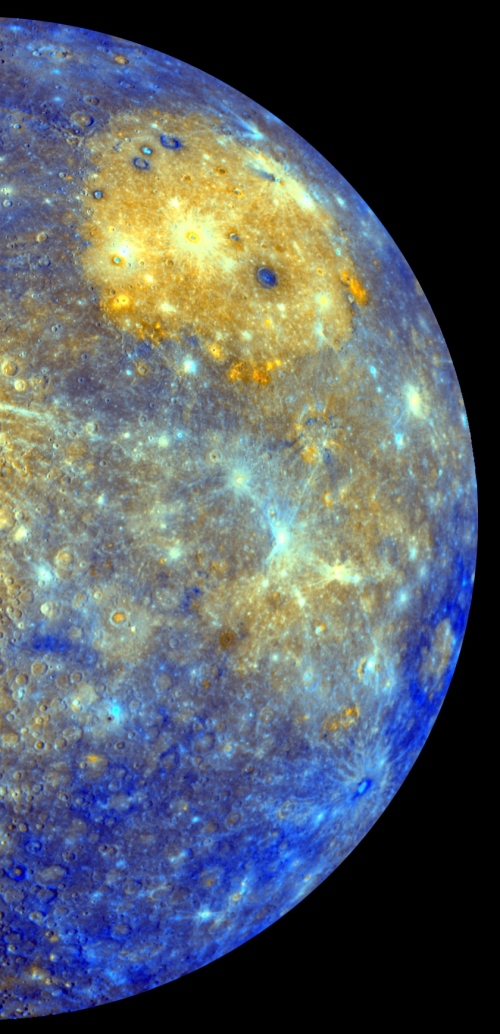WASHINGTON (AP) _ For the first time, Earth has a regular orbiting eye-in-the-sky spying on the solar system's smallest and strangest planet, Mercury.
NASA's spacecraft called Messenger successfully veered into a pinpoint orbit Thursday night after a 6 1/2-year trip and 4.9 billion miles (7.9 billion kilometers) and tricky maneuvering to fend off the gravitational pull of the sun. It is the fifth planet in our solar system that NASA has orbited, in addition to the Earth and the moon.
 |
This image released by NASA shows an enhanced photo image of Mercury from its Messenger probe's 2008 flyby of the planet. (AP-Yonhap News) |
``It was right on the money,'' Messenger's chief engineer, Eric Finnegan, said. Messenger is in orbit that brings it as close as 120 miles (193 kilometers) above the planet's surface. ``This is as close you can possibly get to being perfect.''
``Everybody was whooping and hollering; we are elated,'' Finnegan said. ``There's a lot of work left to be done, but we are there.''
Mercury is not only difficult to get to, but it's has some of the most extremes in the solar system. Temperatures there swing wildly by 1,100 degrees Fahrenheit (600 Celsius). While it gets up to 800 degrees Fahrenheit (425 Celsius) on the planet closest to the sun, it also is so cold and dark in some craters that the temperatures don't get above 300 degrees Fahrenheit below zero (184 degrees Celsius below zero). Radar even shows that there is likely frozen ice in those craters, something Messenger will try to confirm.
In the 1970s, NASA sent a spacecraft, Mariner, whizzing by Mercury, but only got pictures of less than half of the tiny rock.
Robert Strom of the University of Arizona was a scientist on the Mariner and current Messenger missions and he said for a while he thought he wouldn't get a second peek at the eccentric Mercury.
``I am just so thrilled it isn't funny,'' Strom said by telephone minutes after NASA confirmed that Messenger was in orbit.
``Thirty-six years waiting for this day. It's just unbelievable.''
Strom said he and all his colleagues were nervous as the desk-sized spacecraft automatically shifted into an egg-shaped orbit, with controllers on Earth unable to change commands because it took eight minutes for signals to travel the approximately 100 million miles (160 million kilometers) from Mercury to Earth.
``This was not easy. This was a very, very difficult maneuver to get into orbit,'' Strom told The Associated Press.
A NASA Twitter account under Messenger's name gave play-by-play accounts as it arrived at the small planet. This ``Messenger''
``exchanged tweets'' with Voyager 2, one of NASA's oldest and most-distant spacecraft. Voyager 2, launched in 1977 and now at the edge of the solar system, tweeted good luck and Messenger ``answered'' with a tweet: ``Many thanks! Cold out there? Kinda warm where I am.''
Messenger, which cost NASA $446 million, was launched in 2004.
Next month it should start transmitting pictures and investigate Mercury's mysterious magnetic field and unusual density.
``This is when the real mission begins,'' Messenger chief scientist Sean Solomon said an hour after Messenger was safely in Mercury's orbit. ``We are really ready to learn about one of Earth's nearest neighbors for the first time.''
For example, Solomon said Mercury, Venus, Earth and Mars formed at the same time, but Mercury ``came out very different.''
``Mercury is a planet where there are many things going on,'' Solomon said.
<한글 기사>
美탐사선 메신저호, 첫 수성 궤도진입
극점 얼음존재 여부 등 규명 기대
미국의 무인 수성 탐사선 메신저호가 사상 처음으로 수성 궤도 진입에 성공했다.
미 항공우주국(NASA)은 메신저호가 약 6년반 동안 78억9천km를 비행한 끝에 미국 시각 17일 오후 9시(한국시각 18일 오전 11시)께 수성 궤도에 진입했다고 전했다.
NASA는 메신저호가 "태양계 가장 안쪽의 행성에 기술적이고 과학적인 이정표를 세웠다"고 평가했다.
인류가 제작한 우주선이 태양에서 가장 가까운 수성의 궤도를 도는 것은 이번이 처음이다. 또 수성은 NASA의 우주선이 궤도 진입에 성공한 다섯번째 행성이 됐다.
메신저호는 1년간 궤도를 돌며 수성 표면과 주변 대기의 구성 등에 대한 정보를 지구로 송출하게 된다. 메신저호는 수성 지표와 가장 가까울 때 200km, 가장 멀때는 1만5천km 각각 떨어지게 된다.
아울러 메신저호는 오는 23일부터 장착한 첨단 장비들을 본격 가동하게 되며, 다음 달 4일부터 본격적인 과학적 탐사 과업을 수행한다. 아울러 향후 수주동안 NAS A의 기술자들은 메신저호의 시스템이 수성 주변의 높은 온도에도 이상없이 작동하는 지를 집중적으로 확인하게 된다.
NASA는 메신저호를 통해 처음으로 수성에 대한 자세한 정보를 얻게 될 것으로 기대하고 있다.
무인 우주선 매리너호가 1974년과 1975년 각각 수성을 지나친 적이 있지만 메신저호의 궤도 진입에 비하면 `리허설' 수준이었다고 과학자들은 평가한다.
과학자들은 메신저호를 통해 수성의 자기장과 핵에 대한 유용한 정보와 수성극점에 있는 분화구에 실제로 얼음이 존재하는지 등을 파악할 수 있기를 기대하고 있다.
2004년 8월 여정을 시작한 메신저호는 그동안 태양을 15차례 돌았으며, 지구를 한 차례, 금성을 2차례, 수성을 3차례 각각 통과했다. 2008년에는 수성 지표면을 촬영한 사진들을 보내왔다.
한편 메신저호 프로젝트에는 그간 4억4천600만달러의 비용이 투입된 것으로 전해졌다.
(연합뉴스)








